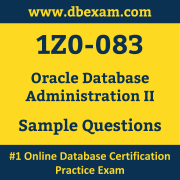01. Which three are true about Optimizer Statistics Advisor?
(Choose three.)
a) It can be run only manually.
b) It is part of the DBMS_ADVISOR package.
c) It can recommend changes to improve the statistics gathering process.
d) It always analyzes all schemas in the database.
e) It runs automatically every night by default.
f) It is part of the DBMS_STATS package.
02. A database is configured in ARCHIVELOG mode. Full RMAN backups are taken and no backup to trace has been taken of the control file. A media failure has occurred.
In which two scenarios is complete recovery possible?
(Choose two.)
a) when any archived log from, before, or after the most recent backup is corrupt.
b) after losing all copies of the control file
c) after losing an archived log from after the most recent backup
d) after losing an archived log from before the most recent backup
e) after losing the SYSTEM tablespace
03. While backing up to an SBT channel, you determine that the read phase of your compressed Recovery Manager (RMAN) incremental level 0 backup is a bottleneck. FORCE LOGGING is enabled for the database.
Which two could improve read performance?
(Choose two.)
a) Increase the size of tape I/O buffers.
b) Disable FORCE LOGGING for the database.
c) Increase the size of the database buffer cache.
d) Enable asynchronous disk I/O.
e) Increase the level of RMAN multiplexing.
04. A user complains about poor database performance. You want to verify if the user's session has waited for certain types of I/O activity.
Which view displays all waits waited on by a session at least once?
a) V$SESSION_EVENT
b) V$SESSTAT
c) V$SESSION_WAIT
d) V$SESSION_WAIT_CLASS
e) V$SESSION
05. Which two are true about Recovery Manager (RMAN) diagnostic message output?
(Choose two.)
a) Media Management messages for SBT devices are always written to sbtio.log.
b) RMAN error stacks should be read from the bottom up as that is the order in which errors are generated.
c) RMAN error stacks should be read from the top down as that is the order in which errors are generated.
d) The RMAN LOG command line clause causes output issued during RMAN command compilation to be written to a log file and to standard output.
e) The RMAN LOG command line clause causes output issued during RMAN command compilation to be written to a log file only.
f) Media Management messages for SBT devices are written to an Oracle trace file.
06. Which two are true about the Oracle database methodology?
(Choose two.)
a) The Oracle Database time model should be used to find the database and instance areas most in need of tuning.
b) Tuning activities should stop once the user is satisfied with performance.
c) Tuning activities should stop once agreed service levels for performance have been met.
d) The database instance memory should always be tuned before tuning any file systems.
e) SQL statements should always be tuned before tuning any file systems.
f) The alert log should be used to find the database and instance areas most in need of tuning.
07. Your container database, CDB1, has an application container, HR_ROOT, with an application PDB, HR_PDB1. You have the required privilege to clone HR_PDB1 to container database CDB2, which does not contain HR_ROOT.
Which two are always true?
(Choose two.)
a) CDB1 and CDB2 must be in shared undo mode.
b) A common user must exist in CDB2 with the CREATE PLUGGABLE DATABASE privilege.
c) All transactions in HR_PDB1 of CDB1 must commit before the cloning process starts.
d) Cloning HR_ROOT automatically clones HR_PDB1.
e) The HR_PDB1 clone created in CDB2 will be in mount state when cloning ends.
08. Which two are true about automatic block repair?
(Choose two.)
a) Automatic block repair can repair blocks with no standby database if DB_BLOCK_CHECKING = TRUE.
b) Real-Time Query must be enabled on a physical standby database for automatic block repair to be done on its primary database.
c) Real-Time Query must be enabled on a physical standby database for automatic block repair to be done on that physical standby database.
d) It is not possible for media corrupt blocks.
e) Real-Time Query must be enabled on a primary database for automatic block repair to be done on any of its physical standby databases.
09. For which two requirements can you use the USER_TABLESPACE clause with the CREATE PLUGGABLE DATABASE command?
(Choose two.)
a) to specify a default tablespace in a PDB cloned from another PDB in the same CDB.
b) to exclude all tablespaces except SYSTEM, SYSAUX, and TEMP when plugging in a PDB.
c) to include specific user tablespaces only when relocating a PDB.
d) to specify the list of user tablespaces to include when moving a non-CDB to a PDB.
e) to exclude a temp tablespace when plugging in a PDB.
f) to specify the list of tablespaces to include when creating a PDB from the CDB seed.
10. Which two are true about SQL Performance Analyzer (SPA)?
(Choose two.)
a) It is integrated with the SQL Access Advisor.
b) It predicts the impact of system changes on SQL workload response time.
c) It provides before and after execution statistics for each SQL statement in the analysis task
d) It offers fine-grained analysis of all the SQL statements in the analysis task as a group.
e) SQL statements that were originally run concurrently are run concurrently by SPA.
 The Oracle Database Administration II (1Z0-083) Sample Question Set is designed to help you prepare for the Oracle Database Administration 2019 Certified Professional certification exam. To become familiar with the actual Oracle Certification exam environment, we suggest you try our Sample Oracle 1Z0-083 Certification Practice Exam.
The Oracle Database Administration II (1Z0-083) Sample Question Set is designed to help you prepare for the Oracle Database Administration 2019 Certified Professional certification exam. To become familiar with the actual Oracle Certification exam environment, we suggest you try our Sample Oracle 1Z0-083 Certification Practice Exam.